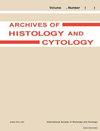河豚肝胰脏组织学与河豚毒素定位的关系
Q4 Medicine
引用次数: 2
摘要
河豚鱼的“肝脏”既有肝脏部分,也有胰腺部分。肝脏部分与人、小鼠、大鼠等哺乳动物肝脏一样具有实质和门静脉区。然而,河豚肝的肝小叶在组织学上不明显。肝实质细胞(肝细胞)和非实质细胞如肝窦内皮细胞和肝星状细胞(维生素a储存细胞,Ito细胞)均存在。实质细胞细胞质内充满大脂肪滴,即肝脏脂肪变性,但未见肝纤维化和肝硬化。胰腺部分可见含有酶原颗粒的胰腺腺泡细胞。河豚毒素主要见于胰腺部分的腺泡细胞;肝实质细胞、肝窦内皮细胞和肝星状细胞均含有河豚毒素。这是第一个证明河豚毒素定位于河豚鱼肝胰腺部分的腺泡细胞和肝部分的非实质细胞的报道。本文章由计算机程序翻译,如有差异,请以英文原文为准。
Histology of the hepatopancreas of puffer fish (Takifugu rubripes) in relation to the localization of tetrodotoxin
The “liver” of puffer fish had both a hepatic portion and a pancreatic portion. The hepatic portion had the parenchyma and the portal area as mammalian livers such as human or mouse or rat. However, the hepatic lobule was not obvious histologically in the puffer liver. In the hepatic parenchyma, both parenchymal cells (hepatocytes) and non-parenchymal cells such as liver sinusoidal endothelial cells and hepatic stellate cells (vitamin A-storing cells, Ito cells) were demonstrated to exist. Cytoplasm of the parenchymal cells was filled with large fat droplets, namely, the liver was in steatosis, but neither hepatic fibrosis nor liver cirrhosis was identified. In the pancreatic portion, pancreatic acinar cells containing zymogen granules were seen. Tetrodotoxin was demonstrated mainly in the acinar cells of the pancreatic portion; hepatic parenchymal cells, liver sinusoidal endothelial cells, and hepatic stellate cells were also shown to contain tetrodotoxin by immunohistochemistry using specific antibody against tetrodotoxin. This is the first report demonstrating the localization of tetrodotoxin in acinar cells of the pancreatic portion and non-parenchymal cells of the hepatic portion in the hepatopancreas of the puffer fish.
求助全文
通过发布文献求助,成功后即可免费获取论文全文。
去求助
来源期刊

Archives of histology and cytology
生物-细胞生物学
自引率
0.00%
发文量
0
期刊介绍:
The Archives of Histology and Cytology provides prompt publication in English of original works on the histology and histochemistry of man and animals. The articles published are in principle restricted to studies on vertebrates, but investigations using invertebrates may be accepted when the intention and results present issues of common interest to vertebrate researchers. Pathological studies may also be accepted, if the observations and interpretations are deemed to contribute toward increasing knowledge of the normal features of the cells or tissues concerned. This journal will also publish reviews offering evaluations and critical interpretations of recent studies and theories.
 求助内容:
求助内容: 应助结果提醒方式:
应助结果提醒方式:


